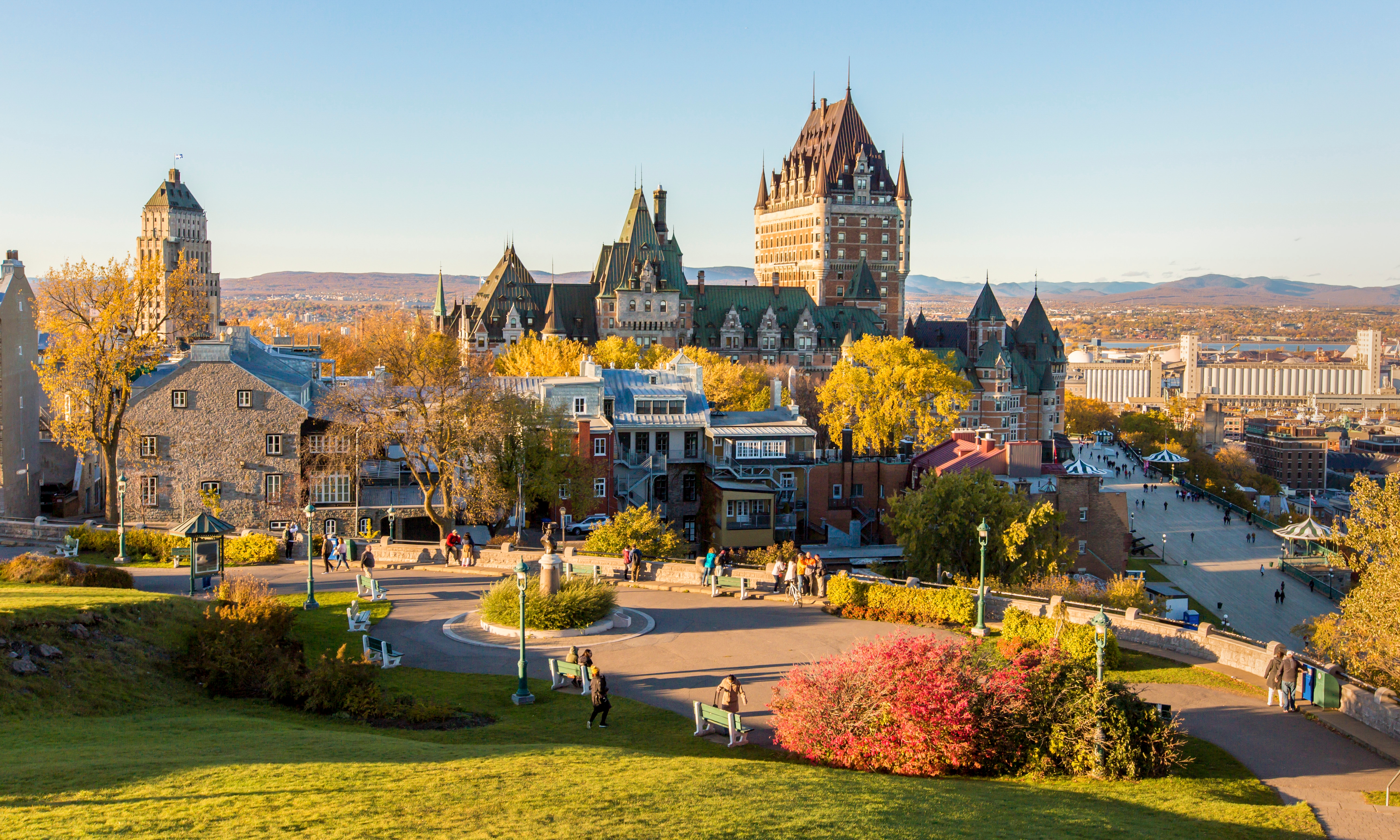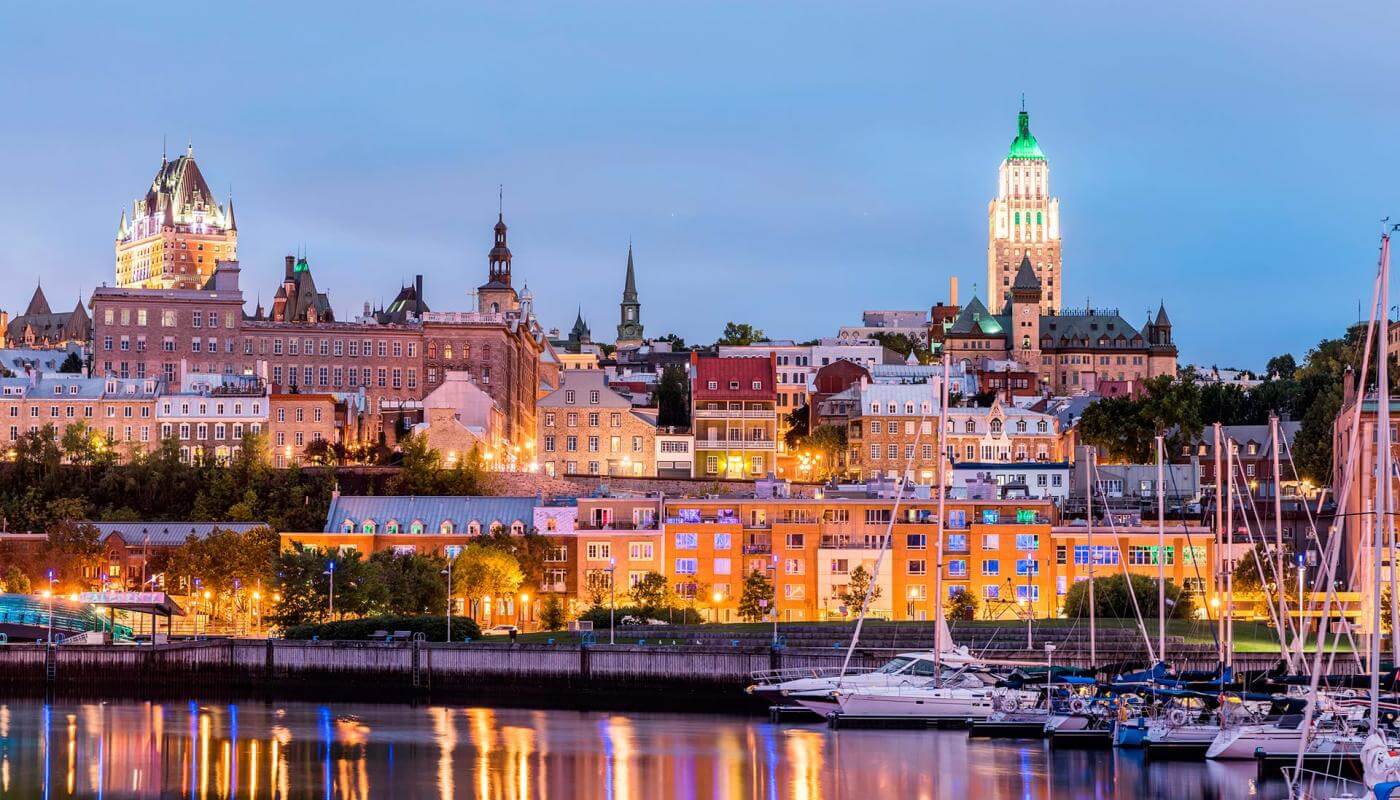



Québec City sits on the Saint Lawrence River in Canada's mostly French-speaking Québec province. Dating to 1608, it has a fortified colonial core, Vieux-Québec and Place Royale, with stone buildings and narrow streets. This area is the site of the towering Château Frontenac Hotel and imposing Citadelle of Québec. The Petit Champlain district’s cobblestone streets are lined with bistros and boutiques.
Best Time to Visit Quebec City, Quebec:
Winter (December to February): Quebec City is famous for its winter charm, especially during the Québec Winter Carnival (the world’s largest winter carnival), held in January and February. With temperatures ranging from -10°C to -15°C (14°F to 5°F), the snow-covered streets, historic Old Quebec, and ice sculptures make it a magical experience. Visitors can also enjoy winter sports like ice skating and tobogganing.
Spring (March to May): Spring is a lovely time to visit Quebec City, with temperatures ranging from 1°C to 13°C (34°F to 55°F). The city begins to thaw, flowers bloom, and you can enjoy outdoor activities before the summer crowds arrive. It’s a great time for walking tours through Old Quebec or enjoying the spring festivals.
Summer (June to August): The most popular time to visit, summer brings warm weather (15°C to 25°C / 59°F to 77°F). It’s perfect for strolling through the cobblestone streets of Old Quebec, visiting the stunning Montmorency Falls, and enjoying outdoor festivals like the Festival d'été de Québec. However, it can be crowded, so it’s best to book accommodations in advance.
Fall (September to November): Fall is one of the most scenic times to visit, with beautiful autumn foliage and milder temperatures (6°C to 18°C / 43°F to 64°F). The fall colors around Old Quebec and the countryside are breathtaking, making it ideal for photography. There are also fewer tourists compared to the summer months, so it's a great time to explore without the crowds.
Best Time to Visit Quebec City, Quebec:
Winter (December to February): Quebec City is famous for its winter charm, especially during the Québec Winter Carnival (the world’s largest winter carnival), held in January and February. With temperatures ranging from -10°C to -15°C (14°F to 5°F), the snow-covered streets, historic Old Quebec, and ice sculptures make it a magical experience. Visitors can also enjoy winter sports like ice skating and tobogganing.
Spring (March to May): Spring is a lovely time to visit Quebec City, with temperatures ranging from 1°C to 13°C (34°F to 55°F). The city begins to thaw, flowers bloom, and you can enjoy outdoor activities before the summer crowds arrive. It’s a great time for walking tours through Old Quebec or enjoying the spring festivals.
Summer (June to August): The most popular time to visit, summer brings warm weather (15°C to 25°C / 59°F to 77°F). It’s perfect for strolling through the cobblestone streets of Old Quebec, visiting the stunning Montmorency Falls, and enjoying outdoor festivals like the Festival d'été de Québec. However, it can be crowded, so it’s best to book accommodations in advance.
Fall (September to November): Fall is one of the most scenic times to visit, with beautiful autumn foliage and milder temperatures (6°C to 18°C / 43°F to 64°F). The fall colors around Old Quebec and the countryside are breathtaking, making it ideal for photography. There are also fewer tourists compared to the summer months, so it's a great time to explore without the crowds.
How to Get There:
By Air: Québec City Jean Lesage International Airport (YQB) is the main airport, located about 16 km (10 miles) west of downtown Quebec City. Direct flights are available from major cities like Montreal, Toronto, and several U.S. cities.
By Train: VIA Rail operates trains to Quebec City from Montreal, offering a comfortable and scenic ride through the countryside.
By Bus: Greyhound and other bus services offer routes to Quebec City from cities across Canada and the U.S.
By Car: Quebec City is easily accessible by car via Autoroute 20 or 40, and it’s about 3 hours from Montreal. If you're traveling from the U.S., it’s about an 8-hour drive from Boston.
Top Attractions in Quebec City:
Old Quebec (Vieux-Québec): A UNESCO World Heritage site, Old Quebec is the heart of the city, with cobblestone streets, charming boutiques, and historic buildings like the iconic Château Frontenac. The area is divided into Upper and Lower Towns, with impressive fortifications and stunning views.
Château Frontenac: This grand castle-like hotel is one of the most photographed buildings in the world. Even if you're not staying here, it's worth visiting to admire the architecture and enjoy the views from the surrounding terraces.
Montmorency Falls: Just 15 minutes from the city center, these 83-meter-high falls are taller than Niagara Falls. You can take a cable car or walk up to the observation deck for stunning views.
Plains of Abraham: A historic park where the Battle of Quebec took place in 1759. Today, it's a peaceful green space offering beautiful views of the St. Lawrence River and a great place for picnics or walks.
Citadelle of Quebec: A fortress located on Cap Diamant, the Citadelle is one of the oldest military installations in North America. It offers tours that teach about Quebec’s military history and provides sweeping views of the city.
Museum of Civilization (Musée de la civilisation): A fascinating museum that showcases Quebec’s culture, history, and Indigenous heritage through interactive exhibits.
La Promenade des Gouverneurs: This scenic walking path along the cliffs offers breathtaking views of the city, the St. Lawrence River, and the surrounding areas.
Rue du Petit-Champlain: A charming, pedestrian-only street lined with art galleries, boutiques, and cafés. It’s the perfect place to shop for unique souvenirs or enjoy a leisurely stroll.
Basilique-cathédrale Notre-Dame de Québec: A stunning cathedral with a rich history, located in the heart of Old Quebec. It’s the oldest Catholic parish church in North America.
Île d'Orléans: A picturesque island just outside Quebec City, known for its beautiful landscapes, local produce, wineries, and charming villages.
Activities to Do in Quebec City:
Explore Old Quebec: Wander through the narrow, cobblestone streets of Vieux-Québec, where you can visit historic sites, enjoy quaint shops, and marvel at the architecture.
Take a Walking Tour: Join a guided walking tour to learn about the history of Old Quebec, its fortifications, and its significant role in North American history.
Visit Montmorency Falls: Go hiking, take the cable car, or walk across the suspension bridge for panoramic views of the falls. In winter, the falls are illuminated and frozen, creating a magical scene.
Cruise the St. Lawrence River: Take a boat cruise to experience Quebec City from the water and enjoy incredible views of the city’s skyline, Old Quebec, and Château Frontenac.
Enjoy Winter Sports: In winter, visit Le Massif de Charlevoix for skiing or snowboarding, or enjoy ice skating and tobogganing in Old Quebec.
Go Wine Tasting on Île d'Orléans: Visit the wineries on this scenic island and sample local wines, cider, and fresh produce.
Relax at Terrasse Dufferin: This promenade near Château Frontenac offers great views of the river and the surrounding area. It’s perfect for a leisurely walk or to catch a performance by local musicians.
Attend the Quebec Winter Carnival: If you’re visiting in January or February, don't miss the iconic Carnaval de Québec, featuring parades, ice sculptures, and fun winter activities.
Explore the Historic Fortifications: Take a walk along the city’s ramparts, which are the only remaining fortified city walls in North America, offering scenic views and historical insights.
Visit the Musée de l'Amérique francophone: Explore the history and heritage of French-speaking North America through a collection of artifacts, documents, and exhibitions.
Accommodation in Quebec City:
Château Frontenac: Stay at this iconic luxury hotel for a regal experience, with views of the St. Lawrence River and Old Quebec. It’s one of the most famous hotels in the world.
Auberge Saint-Antoine: A boutique hotel located in Old Quebec, offering a perfect blend of modern amenities and historic charm. It’s within walking distance of major attractions.
Le Bonne Entente: A luxurious resort offering fine dining, a spa, and elegant rooms, located just a short drive from the city center.
Hotel Clarendon: One of the oldest hotels in Quebec City, located in the heart of Old Quebec. It offers historic charm, modern amenities, and great access to local attractions.
Hotel 71: A stylish boutique hotel in the Old Port area, with sleek rooms and a fantastic restaurant.
Budget Options: For more affordable accommodations, try HI Quebec City Hostel or Auberge Internationale de Québec, offering clean, budget-friendly options in central locations.
Airbnb: There are also numerous Airbnb properties available in Old Quebec and surrounding neighborhoods, offering a more local, personalized stay.
Food and Restaurants in Quebec City:
Le Continental: A fine-dining institution in Old Quebec, known for its classic French cuisine and tableside service. Their steak tartare and flambéed dishes are a must-try.
L’Initiale: A Michelin-starred restaurant offering innovative French cuisine with a modern twist. It’s perfect for special occasions.
La Buche: A cozy restaurant offering traditional Quebecois comfort food, such as poutine, tourtière (meat pie), and maple-infused dishes.
Chez Muffy: Located in the Old Port, this upscale restaurant features a seasonal menu based on local ingredients, often with a focus on seafood and farm-to-table dishes.
Le Lapin Sauté: Known for its rabbit dishes, this rustic bistro offers Quebecois specialties and is located in the picturesque Petit-Champlain district.
Paillard: A casual French bakery and café that serves delicious pastries, sandwiches, and coffee. Perfect for breakfast or a light lunch.
Bistro Sous le Fort: This charming bistro offers classic French dishes and Quebecois specialties in a cozy atmosphere, located in Old Quebec.
Le Chic Shack: A modern take on fast food, serving gourmet burgers, poutine, and local craft beers in a casual setting.
Marché du Vieux-Port: For a local experience, visit this market for fresh produce, cheeses, meats, and other local specialties, perfect for a picnic or take-home goodies.
Café du Marché: A casual spot for coffee, pastries, and light bites, ideal for a quick break during your sightseeing.
Local Culture in Quebec City:
French Influence: Quebec City’s culture is deeply rooted in French heritage. French is the official language, and the city has a distinctly European feel, with French cuisine, art, and architecture shaping the city’s identity.
Winter Carnival: The Carnaval de Québec is a major cultural event that celebrates Quebec’s winter traditions with parades, ice sculptures, and festive activities.
Historical Significance: Quebec City is a place of historical importance, especially as one of the oldest cities in North America. It was the site of pivotal battles in Canadian history, including the Battle of Quebec in 1759.
Music and Arts: The city has a thriving arts scene, with numerous art galleries, theaters, and music festivals. The Festival d'été de Québec is one of the largest music festivals in Canada, attracting international artists.
Cuisine: Quebec’s food culture blends French and Indigenous influences, with dishes like poutine, tourtière, and maple syrup-based desserts being local staples. The region is also known for its cheese, wine, and cider.
Winter Sports: Due to its snowy climate, Quebec City has a strong winter sports culture, with skiing, snowboarding, and ice skating being popular activities in the colder months.
Indigenous Culture: The Quebec region is home to several Indigenous groups, and visitors can learn about their culture, art, and history at museums and cultural centers, such as the Huron-Wendat Nation.